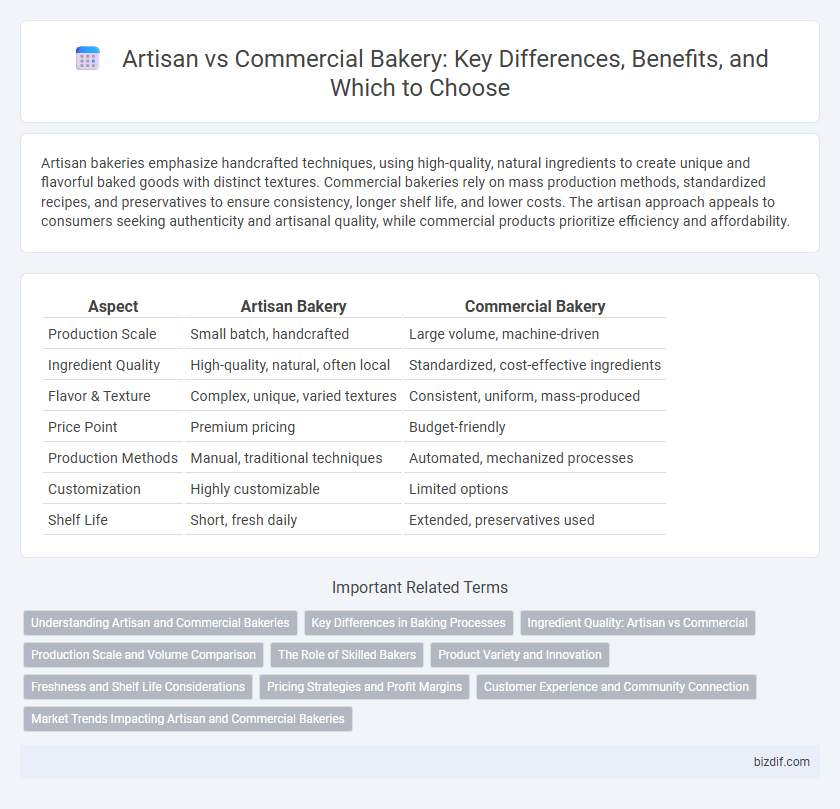Artisan bakeries emphasize handcrafted techniques, using high-quality, natural ingredients to create unique and flavorful baked goods with distinct textures. Commercial bakeries rely on mass production methods, standardized recipes, and preservatives to ensure consistency, longer shelf life, and lower costs. The artisan approach appeals to consumers seeking authenticity and artisanal quality, while commercial products prioritize efficiency and affordability.
Table of Comparison
| Aspect | Artisan Bakery | Commercial Bakery |
|---|---|---|
| Production Scale | Small batch, handcrafted | Large volume, machine-driven |
| Ingredient Quality | High-quality, natural, often local | Standardized, cost-effective ingredients |
| Flavor & Texture | Complex, unique, varied textures | Consistent, uniform, mass-produced |
| Price Point | Premium pricing | Budget-friendly |
| Production Methods | Manual, traditional techniques | Automated, mechanized processes |
| Customization | Highly customizable | Limited options |
| Shelf Life | Short, fresh daily | Extended, preservatives used |
Understanding Artisan and Commercial Bakeries
Artisan bakeries specialize in handcrafted breads and pastries made using traditional methods, high-quality ingredients, and slower fermentation processes to enhance flavor and texture. Commercial bakeries focus on large-scale production, utilizing automated equipment and standardized recipes to ensure consistency and efficiency across high volumes. Understanding these differences helps consumers appreciate the unique qualities of artisan products versus the convenience and affordability of commercial baked goods.
Key Differences in Baking Processes
Artisan baking emphasizes handcrafted techniques, using natural fermentation and longer proofing times to develop complex flavors and textures, whereas commercial baking relies on mechanized processes and accelerants to produce large volumes quickly. Artisan bakers often prefer small batch production with high-quality, locally sourced ingredients, while commercial operations prioritize consistency and scalability using standardized recipes and commercial additives. The key differences lie in the precision of process control, ingredient quality, and the balance between traditional methods and mass production efficiency.
Ingredient Quality: Artisan vs Commercial
Artisan bakeries prioritize high-quality, often locally sourced ingredients like organic flour, real butter, and natural leavening agents, enhancing flavor and nutritional value. Commercial bakeries commonly use cost-effective, processed ingredients such as preservatives, artificial additives, and refined sugars to maximize shelf life and production efficiency. This difference in ingredient quality significantly impacts the taste, texture, and health benefits of bakery products.
Production Scale and Volume Comparison
Artisan bakeries typically produce limited batches with a focus on handcrafted quality and unique flavor profiles, resulting in lower volume output. Commercial bakeries operate on a large scale, utilizing automated processes and industrial equipment to achieve high production volumes efficiently. The difference in production scale directly impacts pricing, product variety, and market reach between artisan and commercial bakery products.
The Role of Skilled Bakers
Skilled bakers play a crucial role in artisan bakeries, where traditional techniques and high-quality ingredients create unique, handcrafted products with distinctive flavors and textures. In contrast, commercial bakeries rely more on automation and standardized processes to produce large quantities efficiently but often sacrifice the nuanced expertise that skilled bakers provide. The mastery of skilled bakers in artisan settings ensures consistent craftsmanship, creativity, and the preservation of baking heritage.
Product Variety and Innovation
Artisan bakeries excel in offering diverse, handcrafted products with unique flavors and innovative recipes that showcase creativity and traditional techniques. Commercial bakeries focus on mass production, standardizing products to ensure consistency and efficiency, which can limit variety and experimentation. The artisan approach fosters continual innovation through small-batch experimentation, while commercial operations prioritize scale and uniformity over product diversity.
Freshness and Shelf Life Considerations
Artisan bakery products prioritize freshness by using small-batch production and natural ingredients, leading to a shorter shelf life but superior flavor and texture. Commercial bakery items often incorporate preservatives and stabilizers to extend shelf life, enabling mass distribution but compromising some aspects of freshness. Consumers seeking quality and natural taste typically prefer artisan breads, while convenience and longer storage time drive demand for commercial baked goods.
Pricing Strategies and Profit Margins
Artisan bakeries often adopt premium pricing strategies reflecting their use of high-quality, locally sourced ingredients and handcrafted techniques, resulting in higher profit margins per product despite lower volume sales. Commercial bakeries rely on economies of scale and mass production to offer lower prices, enabling greater overall sales volume but typically yielding thinner profit margins per item. Understanding the balance between production costs, price points, and consumer expectations is crucial for optimizing profitability in both artisan and commercial bakery models.
Customer Experience and Community Connection
Artisan bakeries prioritize handcrafted techniques and high-quality ingredients, delivering a personalized customer experience that fosters loyalty and trust. Commercial bakeries focus on mass production and consistency, often sacrificing individual customer interaction but offering wide product availability. Artisan bakeries strengthen community connections by supporting local suppliers and hosting events, creating a vibrant neighborhood hub unlike large-scale commercial operations.
Market Trends Impacting Artisan and Commercial Bakeries
Artisan bakeries experience growth driven by consumer demand for handcrafted, high-quality, and locally sourced products emphasizing unique flavors and traditional methods. Commercial bakeries leverage advanced automation and scale to meet the increasing demand for affordable, consistent, and mass-produced baked goods, dominating supermarket and convenience store markets. Market trends such as health consciousness and sustainability are pushing both sectors to innovate with organic ingredients and eco-friendly packaging to capture diverse customer preferences.
Artisan vs Commercial Infographic

 bizdif.com
bizdif.com